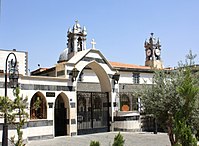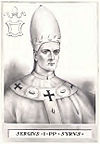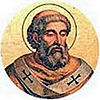A | B | C | D | E | F | G | H | CH | I | J | K | L | M | N | O | P | Q | R | S | T | U | V | W | X | Y | Z | 0 | 1 | 2 | 3 | 4 | 5 | 6 | 7 | 8 | 9
 Our Lady of Saidnaya Monastery, one of the oldest monasteries in the world | |
| Total population | |
|---|---|
| ~300,000 (2022 estimate) | |
| Religions | |
| Greek Orthodox Church of Antioch, Maronite Church, Assyrian Church of the East, Syriac Orthodox Church, Syriac Catholic Church, Armenian Orthodox Church and Armenian Catholic Churches, some Protestant | |
| Languages | |
| Arabic, Syriac, Aramaic |
| Christianity by country |
|---|
 |
|
|
Christianity in Syria has among the oldest Christian communities on Earth, dating back to the first century AD, and has been described as a "cradle of Christianity".[1] With its roots in the traditions of St. Paul the Apostle and St. Peter the Apostle, Syria quickly became a major center of early Christianity and produced many significant theologians and church leaders. Of the 325 bishops who took part in the First Council of Nicea in 325 AD, twenty were from Syria. Over the centuries, Syrian Christians have played a vital role in shaping Christian thought and practice, contributing to the development of various liturgical traditions, monastic movements, and theological schools. St. Paul the Apostle famously converted to Christianity on the road to Damascus, and Syria has produced two Popes: Pope Anicetus (157–168 AD) and Pope Gregory III (731–741 AD). Their legacy includes the establishment of some of the most ancient churches, monasteries, and pilgrimage sites, such as the 5th century remains of the Church of Saint Simeon Stylites, Our Lady of Saidnaya Monastery, and the Cathedral of Constantine and Helen.[2]
However, in recent times, the Syrian Christian community has faced numerous challenges, including ongoing and severe persecution, displacement, and emigration. Christians in Syria made up about 10% of the pre-war Syrian population but now makes up less than 2%, falling from 1.5 million in 2011 to just 300,000 in 2022 due to widespread persecution by Islamic terrorists and the impact of the Syrian Civil War. Christians in Syria have also been subjected to violence and discrimination by Islamic State fighters during their control of large areas of the country. Their churches have been converted into military headquarters, and their property confiscated. Persecution of Christians in Syria has further intensified since.[3][4][5] In Aleppo, the country's second largest city, the proportion of Christian residents fell from 12% pre-war to 1.4% in 2023 with more than 20 churches damaged during the war.[6] The city of Idlib has been almost entirely depopulated of its Christian population under Islamist rule.[7] Some governments and organisations including the United States have claimed that the persecution of Christians in the Middle East and North Africa, especially in Syria and Iraq, constitute an act of genocide.[8][9][10][11][12][13]
The country's largest Christian denomination is the Greek Orthodox Church of Antioch,[14][15] closely followed by the Maronite Church and the Assyrian Church of the East.[15] There is a small minority of Protestants in the country.[16]
Overview
In the late Ottoman rule, a large percentage of Syrian Christians emigrated from Syria, especially after the bloody chain of events that targeted Christians in particular in 1840, the 1860 massacre, and the Assyrian genocide. According to historian Philip Hitti, approximately 90,000 Syrians arrived in the United States between 1899 and 1919 (more than 90% of them Christians).[17] The Syrians referred include historical Syria or the Levant encompassing Syria, Lebanon, Jordan and Palestine. Syrian Christians tend to be relatively wealthy and highly educated.[18]
According to the Catholic charity group Aid to the Church (ACN), number of Christians residing in Syria is estimated to have reduced from 2.1 million (10% of population) in 2011 to around 300,000 (less than 2%) in 2022. The decrease is due to large-scale emigration of Christians to Europe triggered by deteriorating living conditions caused by the civil war.[19] US State Department estimates that Syrian Christians comprise 2.5-3% of the total population inside Syria, as of 2022.[20]
Origins

The Christian population of Syria comprised 10% of the Syrian population before 2011.[21] Estimates of the number of Christians in Syria in 2022 range from less than 2% to around 2.5% of the total Syrian population.[15][22]
Most Syrians are members of either the Greek Orthodox Church of Antioch (700,000), or the Syriac Orthodox Church. The vast majority of Catholics belong to the Melkite Greek Catholic Church. Other Eastern Catholic churches include the Maronite Church, Syriac Catholic Church, Armenian Catholic Church, Chaldean Catholic Church; there is also a small number of Latin Church Catholics. The rest belong to the Eastern communions, which have existed in Syria since the earliest days of Christianity when all Christians were part of the One, Holy, Catholic and Apostolic Church. The main Eastern groups are:
- the autocephalous Eastern Orthodox churches;
- the Eastern Catholic Churches, which are in communion with Rome;
- and the independent Assyrian Church of the East (i.e., the "Nestorian" Church). Followers of the Assyrian Church of the East are almost all Eastern Aramaic speaking ethnic Assyrians/Syriacs whose origins lie in Mesopotamia, as are some Oriental Orthodox and Catholic Christians. Even though each group forms a separate community, Christians nevertheless cooperate increasingly. Roman Rite, Western Latin Church Catholicism and Protestantism were introduced by missionaries but only a small number of Syrians are members of Western rites.
The schisms that brought about the many sects resulted from political and doctrinal disagreements. The doctrine most commonly at issue was the nature of Christ. In 431, the Nestorians were separated from the main body of the Church because of their belief in the dual character of Christ, i.e., that he had two distinct but inseparable "qnoma" (ܩܢܘܡܐ, close in meaning to, but not exactly the same as, hypostasis), the human Jesus and the divine Logos. Therefore, according to Nestorian belief, Mary was not the mother of God but only of the man Jesus. The Council of Chalcedon, representing the mainstream of Christianity, in 451 confirmed the dual nature of Christ in one person; Mary was therefore the mother of a single person, mystically and simultaneously both human and divine. The Miaphysites taught that the Logos took on an instance of humanity as His own in one nature. They were the precursors of the present-day Syrian and Armenian Orthodox churches.
By the thirteenth century, breaks had developed between Eastern or Greek Christianity and Western or Latin Christianity. In the following centuries, however, especially during the Crusades, some of the Eastern churches professed the authority of the pope in Rome and entered into or re-affirmed communion with the Catholic Church. Today called the Eastern Catholic churches, they retain a distinctive language, canon law and liturgy.
Eastern Orthodoxy


The largest Christian denomination in Syria is the Greek Orthodox Church of Antioch (officially named the Orthodox Patriarchate of Antioch and All the East), also known as the Melkite church after the 5th and 6th century Christian schisms, in which its clergy remained loyal to the Eastern Roman Emperor ("melek") of Constantinople.
Adherents of that denomination generally call themselves "Rūm" which means "Eastern Romans" or "Asian Greeks" in Arabic. In that particular context, the term "Rūm" is used in preference to "Yūnāniyyūn" which means "European Greeks" or Ionians in Classical Arabic. The appellation "Greek" refers to the Koine Greek liturgy used in their traditional prayers and priestly rites.
Members of the community sometimes also call themselves "Melkites", which literally means "supporters of the emperor" in Semitic languages - a reference to their past allegiance to Roman and Byzantine imperial rule. But, in the modern era, this designation tends to be more commonly used by followers of the local Melkite Catholic Church.
Syrians from the Greek Orthodox Community are also present in the Hatay Province of Southern Turkey (bordering Northern Syria), and have been well represented within the Syrian diasporas of Brazil, Argentina, Mexico, the United States, Canada and Australia.
Oriental Orthodoxy
Traditional Christianity in Syria is also represented by Oriental Orthodox communities, that primarily belong to the ancient Syriac Orthodox Church, and also to the Armenian Apostolic Church.
Syriac Orthodox Church
The Syriac Orthodox Church is the largest Oriental Orthodox Christian group in Syria. The Syriac Orthodox or Jacobite Church, whose liturgy is in Syriac, was severed from the favored church of the Byzantine Empire (Eastern Orthodoxy), over the Chalcedonian controversy.
Armenian Apostolic Church

The Armenian Apostolic Church is the second largest Oriental Orthodox Christian group in Syria. It uses an Armenian liturgy and its doctrine is Miaphysite (not monophysite, which is a mistaken term used or was used by the Chalcedonian Catholics and Chalcedonian Orthodox).
Catholic Church




Of the Eastern Catholic Churches the oldest is the Maronite, with ties to Rome dating at least from the twelfth century. Their status before then is unclear, some claiming it originally held to the Monothelite heresy up until 1215, while the Maronite Church claims it has always been in union with Rome. The liturgy is in Aramaic (Syriac). The Patriarchate of Antioch never recognized the mutual excommunications of Rome and Constantinople of 1054, so it was canonically still in union with both. After a disputed patriarchal election in 1724, it divided into two groups, one in union with Rome and the other with Constantinople. The term "Melkite" is in use mostly in reference to the Melkite Greek Catholic Church. Like its sister-church the Greek Orthodox Church of Antioch ('Eastern Orthodox'), the Melkite Catholics both Greek and Arabic in its form of the liturgy. Most of the 375,000 Catholics in Syria belong to the Melkite Greek Catholic Church, the rest are members of the Latin Church, Maronites (52,000), Armenian or Syriac Rites.
Popes of the Catholic Church
Seven popes from Syria ascended the papal throne.[23][24] Many of them lived in Italy. Pope Gregory III,[25][26] was the last pope born outside Europe before Francis (elected in 2013).
| Numerical order | Pontificate | Portrait | Name English · Regnal |
Personal name | Place of birth | Notes |
|---|---|---|---|---|---|---|
| 1 | 33 – 64/67 | 
|
St Peter PETRUS |
Simon Peter |
Bethsaida, Galilea, Roman Empire | Saint Peter was from village of Bethsaida, Gaulanitis, Syria, Roman Empire |
| 11 | 155 to 166 | 
|
St Anicetus ANICETUS |
Anicitus | Emesa, Syria | Traditionally martyred; feast day 17 April |
| 82 | 12 July 685 – 2 August 686 (1 year+) |

|
John V Papa IOANNES Quintus |
Antioch, Syria | ||
| 84 | 15 December 687 – 8 September 701 (3 year+) |

|
St Sergius I Papa Sergius |
Sicily, Italy | Sergius I was born in Sicily, but he was from Syrian parentage[27] | |
| 87 | 15 January 708 to 4 February 708 (21 days) |

|
Sisinnius Papa SISINNIUS |
Syria | ||
| 88 | 25 March 708 – 9 April 715 (7 years+) |

|
Constantine Papa COSTANTINUS sive CONSTANTINUS |
Syria | Last pope to visit Greece while in office, until John Paul II in 2001 | |
| 90 | 18 March 731 to 28 November 741 (10 years+) |

|
St Gregory III Papa GREGORIUS Tertius |
Syria | Third pope to bear the same name as his immediate predecessor. |
Protestant Churches
In Syria, there is also a minority of Protestants. Protestantism was introduced by European missionaries and a small number of Syrians are members of Protestant denominations. The Gustav-Adolf-Werk (GAW) as the Protestant Church in Germany Diaspora agency actively supports persecuted Protestant Christians in Syria with aid projects.[28] A 2015 study estimates some 2,000 Muslim converted to Christianity in Syria, most of them belonging to some form of Protestantism.[29]
By one estimate made by Elisabe Granli from University of Oslo, around 1,920 Syrian Druze converted to Christianity,[30] according to the same study Christian of Druze background (Druze converts to Christianity) still regard themselves as Druze,[30] and they claims that there is no contradiction between being Druze and being Christian.[30]
Demographics
The number of Christians in Syria has been disputed for many decades. There has been no official census on religion in Syria since the 1960s.

